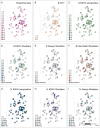This is a preprint.
Factors affecting Kaposi's sarcoma-associated herpesvirus transmission in rural Ugandan households, a longitudinal study
- PMID: 39315255
- PMCID: PMC11419167
- DOI: 10.21203/rs.3.rs-4855275/v1
Factors affecting Kaposi's sarcoma-associated herpesvirus transmission in rural Ugandan households, a longitudinal study
Update in
-
Factors affecting Kaposi's sarcoma-associated herpesvirus transmission in rural Ugandan households, a longitudinal study.Infect Agent Cancer. 2024 Oct 3;19(1):49. doi: 10.1186/s13027-024-00610-6. Infect Agent Cancer. 2024. PMID: 39363326 Free PMC article.
Abstract
Background: We report the impact of HIV infection within a household on oral Kaposi's sarcoma-associated herpesvirus (KSHV) shedding.
Methods: We enrolled 469 individuals from 90 households. Mouthwash rinse samples collected at three monthly visits, were analyzed for KSHV DNA using quantitative polymerase chain reaction (qPCR). Generalized linear mixed effects logistic models were applied to analyze factors associated with KSHV ever shedding, and among shedders, always versus intermittent shedding. Linear mixed effects models were applied to models of KSHV viral loads. Intraclass correlation coefficients (ICCs) were calculated to assess the contribution of household-level factors to variations in shedding probabilities. Hotspot analyses of geospatial feature clusters were calculated using Getis-Ord Gi* statistic and visualized using inverse distance weighted interpolation.
Results: Analyses included 340 KSHV seropositive individuals, aged 3 + years, with qPCR results from 89 households. Forty households had 1 + persons living with HIV (PLWH), while 49 had none. Among participants, 149(44%) were KSHV ever shedders. Of 140 who shed KSHV at two or more visits, 34(24%) were always shedders. Increasing number of KSHV seropositive household members was significantly associated with ever shedding [Odds ratio(OR) (95% Confidence Interval(95%CI)):1.14(1.03,1.26);p = 0.013]. Among KSHV shedders, a statistically significant age-related trend was identified with 10-19 years being more likely to be always shedders (type III test p = 0.039) and to have higher viral loads (type III test p = 0.027). In addition, higher viral loads were significantly associated with increasing number of household members [coefficient(95%CI):0.06(0.01,0.12);p = 0.042], increasing number of KSHV seropositive members [coefficient(95%CI):0.08(0.01,0.15);p = 0.021], and living in households with 1 + PLWH [coefficient(95%CI):0.51(0.04,0.98);p = 0.033]. Always shedders exhibited higher viral loads than intermittent shedders [coefficient(95%CI):1.62(1.19,2.05);p < 0.001], and viral loads increased with the number of visits where KSHV DNA was detected in saliva (type III test p < 0.001). Household-level factors attributed for 19% of the variability in KSHV shedding (ICC:0.191;p = 0.010). Geospatial analysis indicated overlapping hotspots of households with more KSHV seropositive individuals and KSHV shedders, distinct from areas where PLWH were clustered.
Discussion: KSHV oral shedding is influenced by multiple factors at the individual, household, and regional levels. To mitigate ongoing KSHV transmission a comprehensive understanding of factors contributing to oral KSHV reactivation and transmission within households is needed.
Keywords: HHV-8; HIV; Household cohort; KSHV; Kaposi’s sarcoma-associated herpesvirus; Longitudinal Follow-up; Saliva; Shedding; Transmission; sub-Saharan Africa.
Conflict of interest statement
Competing interests.The authors declare that they have no competing interests. All authors significantly contributed to this manuscript.
Figures


References
-
- Brayfield BP, Kankasa C, West JT, Muyanga J, Bhat G, Klaskala W, et al. Distribution of Kaposi sarcoma-associated herpesvirus/human herpesvirus 8 in maternal saliva and breast milk in Zambia: implications for transmission. J Infect Dis. 2004;189(12):2260–70. - PubMed
-
- Blackbourn DJ, Lennette ET, Ambroziak J, Mourich DV, Levy JA. Human herpesvirus 8 detection in nasal secretions and saliva. J Infect Dis. 1998;177(1):213–6. - PubMed
-
- Mbulaiteye SM, Pfeiffer RM, Engels EA, Marshall V, Bakaki PM, Owor AM, et al. Detection of kaposi sarcoma-associated herpesvirus DNA in saliva and buffy-coat samples from children with sickle cell disease in Uganda. J Infect Dis. 2004;190(8):1382–6. - PubMed
-
- de Franca TR, de Araujo RA, Ribeiro CM, Leao JC. Salivary shedding of HHV-8 in people infected or not by human immunodeficiency virus 1. J Oral Pathol Med. 2011;40(1):97–102. - PubMed
Publication types
Grants and funding
LinkOut - more resources
Full Text Sources

